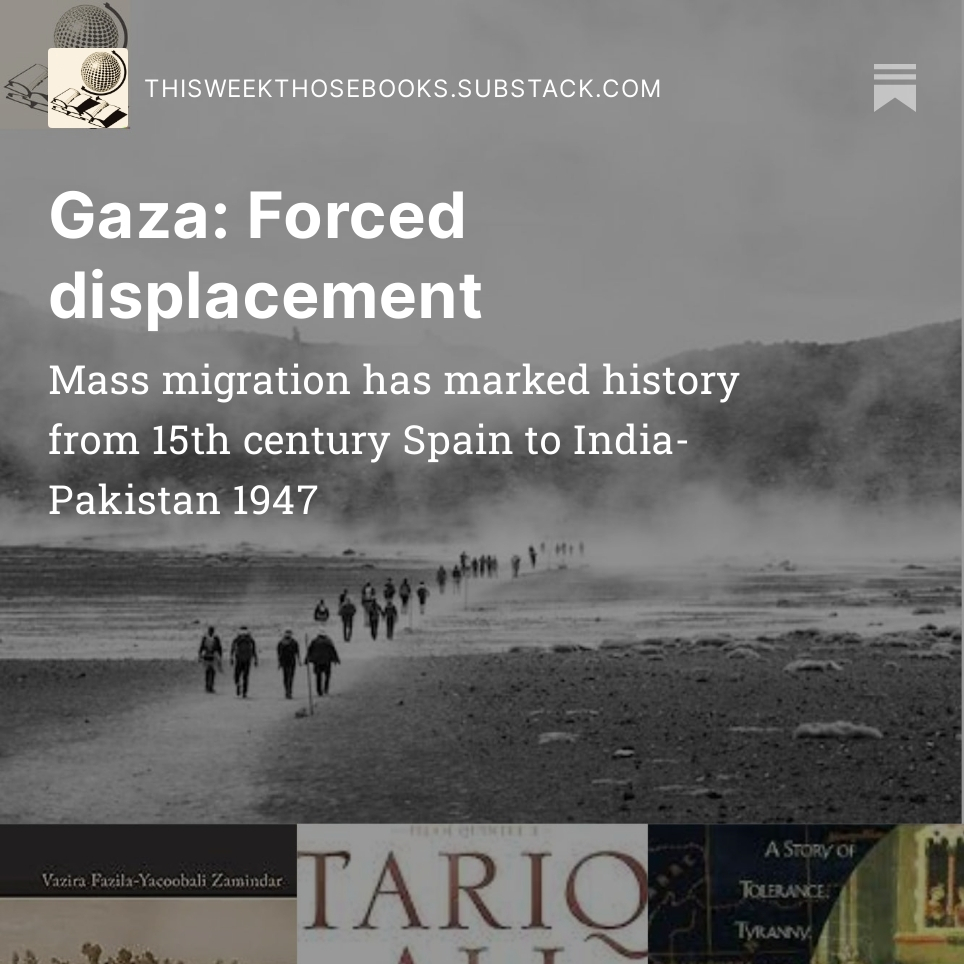Gaza: Forced displacement
Here's the full version of the Oct18 This Week, Those Books. Sign up for free at https://thisweekthosebooks.com/ and get the post the day it drops

Welcome to This Week, Those Books, your rundown on books new and old that resonate with the week’s big news story.
The few minutes it takes to read this newsletter will make you smarter, faster. If you’d rather listen, click on the audio button above for a human, not AI, voiceover by my close collaborator Michael. These book suggestions – complete with summary, quotes and a visceral response rating – could point you to your next read or sort out watercooler convo and supper small talk. Please share. Find me on Twitter, LinkedIn, Facebook or YouTube.
Yours,

Israel’s fight against the Palestinian group Hamas has the world holding its breath, waiting to see what happens next in the Middle East. The majority of northern Gaza’s one million Palestinians have reportedly been forced to leave their bombed and besieged homes for a desperately uncertain future.
Forced mass migrations have been a tragic and painful reality of human history. Conflicted historical events often give rise to contested interpretations and some atrocities that resulted in forced migrations are accorded more attention than others. The crimes of Hitler’s Third Reich prompted American historian Arno J. Mayer to ask “Why did the heavens not darken?” but experts say, the question cannot – and should not – be confined to that moment in time.
Some examples of large-scale forced movements of peoples:
- Over nearly 200 years starting in the 15th century, Catholic Spain expelled 160,000 Jews and 300,000 Muslims.
- An estimated 20 million slaves were forced to migrate by European slave traders operating in Africa from the 16th to the 19th century, with further numbers dying en route.
- Nazi Germany deported roughly seven to eight million people during World War II (1939–45).
- The Soviet Union expelled some 10 million ethnic Germans from eastern Europe in the closing year of that war and afterwards.
- Roughly 14 million people fled in one direction or another during the partition of British India into the newly independent nation states of India and Pakistan in the late 1940s.
- More recently, armed conflict has resulted in several massive forced migrations. Nearly four million people left Afghanistan after the 2021 Taliban reconquest and three million left in the 1980s. Five million poured out of Syria in the 2010s.
- A historian details the long-term effects of forced migration between India and Pakistan.
- A novelist portrays the narrowing life options for a prosperous Muslim family in 15th century Spain.
- An account of how and why Jews were expelled from mediaeval Spain.
- The Long Partition and the Making of Modern South Asia: Refugees, Boundaries, HistoriesBy: Vazira Fazila-Yacoobali Zamindar
Publisher: Columbia University Press
Year: 2007

Vazira Fazila-Yacoobali Zamindar, of Brown University in the US, spent more than two years on ethnographic and archival research trying to suture the “severed histories” of India and Pakistan’s forcibly displaced peoples during the sub-continent’s 1947 Partition. This remarkable book is the result and it asks us to note the “bureaucratic violence” that added to the collective suffering. The bureaucratic state, she writes, drew political boundaries and nationalised identities, drafting limits to the “ideological nation” by making refugees “a governmental category…marked by religious community”. Thus, post-colonial India was “able to push out and dispossess Muslims…as it bounded a new nation for the well-being of ‘our people’.” And Pakistan, which was claimed ideologically to ‘safeguard’ the interest of all Muslims on the sub-continent, argued “it could simply not accommodate all the Muslim refugees that might want to come to Pakistan from India”. The decades since have only ossified the divide, resulting in a continuing and long partition.
Zamindar, who is also from “a divided family”, starts by noting the “indelible images of Partition…historic train and foot conveys, the old and the young huddled together, carrying few if any belongings…”


- Shadows of the Pomegranate TreeBy: Tariq Ali
Publisher: Chatto & Windus
Year: 1992

This historical novel is the first in Tariq Ali’s series on the clash between Islam and Christianity. It opens with a violent book-burning scene, centuries of Spanish Muslim texts going up in smoke. The Muslim kingdom of Granada has fallen to the Christian armies of King Ferdinand and Queen Isabella.The noble Banu Hudayl clan, which migrated to Spain from Damascus hundreds of years ago, is faced with dramatic social, political and religious changes. With 15th century Spain pursuing a programme of Inquisition and forced religious conversion, there is no room for anyone deemed the ‘other’.
Choice quotes:
“The heathen could only be eliminated as a force if their culture was completely erased.”

- The End of Days: A Story of Tolerance, Tyranny and the Expulsion of the Jews from SpainBy: Erna Paris
Publisher: Prometheus Books
Year: 1995

What unites 14th century Spain and the 21st century United States? In America, evangelical Christians believe in what’s called the “end of days” or end times, when all Jews are converted and there is the second coming of Christ. According to scholar Bart Ehrman, it has caused personal and psychological damage, “affected our world in ways you might not expect, involving carnage, US foreign policy and the welfare of our planet”. The late Canadian journalist Erna Paris writes about the mediaeval Spanish government campaign that forced the Jews to leave because they refused to give up their faith.

